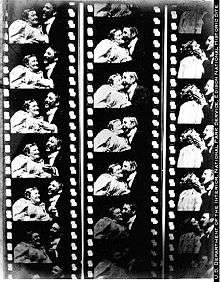The Kiss (1896 film)
The Kiss (also known as The May Irwin Kiss, The Rice-Irwin Kiss and The Widow Jones) is an 1896 film, and was one of the first films ever shown commercially to the public. Around 18 seconds long, it depicts a re-enactment of the kiss between May Irwin and John Rice from the final scene of the stage musical The Widow Jones. The film was directed by William Heise for Thomas Edison. The film was produced in April 1896 at the Edison Studios of Edison, the first movie studio in the United States. At the time, Edison was working at the Black Maria studios in West Orange, New Jersey.
| The Kiss | |
|---|---|
| Directed by | William Heise |
| Starring | May Irwin John Rice |
| Distributed by | Thomas A. Edison, Inc. |
Release date |
|
Running time | 18 seconds |
| Country | United States |
| Language | Silent |
In 1999, the short was deemed "culturally significant" by the United States Library of Congress and selected for preservation in the National Film Registry.
Release
The film was released in April 1896 and was publicized in a sponsored article in the New York World about actors kissing on stage. The article discussed the controversy surrounding onstage kissing and, along with an illustration of the Irwin and Rice's kiss, referred readers to The Widow Jones and the Edison film. The campaign sought to bring attention to the newspaper, play, and movie all at once.[1]
The film was one of the last shot at Edison's Black Maria and was sold to exhibitors for $7.50 ($228 in 2018). By the fall of 1896, many theaters were showing The Kiss at the end of every show.[1]
Reaction

The film contained the very first kiss on film, with a close-up of a nuzzling couple followed by a short peck on the lips ("the mysteries of the kiss revealed"). The kissing scene was denounced as shocking and obscene to early moviegoers and caused the Roman Catholic Church to call for censorship and moral reform, as kissing in public at the time could lead to prosecution.[2]
The film caused a scandalized uproar and occasioned disapproving newspaper editorials and calls for police action in many places where it was shown. One contemporary critic wrote, "The spectacle of the prolonged pasturing on each other's lips was beastly enough in life size on the stage but magnified to gargantuan proportions and repeated three times over it is absolutely disgusting."[3]
However, according to Dengler (1979) in the Journal of Popular Film and Television, the shocked reaction of the general public is a myth. [4]
The Edison catalogue advertised it this way: "They get ready to kiss, begin to kiss, and kiss and kiss and kiss in a way that brings down the house every time."
Because Thomas Edison produced the world’s first kiss on film, it has often been remarked that Thomas Edison was the first pornographer in film, in a sense. This opinion is mentioned in The Big Bang Theory Season 11 Episode 8. [5]
Perhaps in defiance and "to spice up a film", this was followed by many kiss imitators and take-offs, including Something Good – Negro Kiss (1898),[6] The Kiss in the Tunnel (1899) and The Kiss (1900).
Public exposure
For a number of years, it was believed that a showing of The Kiss was the first film publicly shown in Canada, projected in West End Park, Ottawa, on July 21, 1896. It has since been learned that the competing Lumière Brothers Cinematograph had already exhibited different films in Montreal 24 days earlier, on June 27, 1896.[7]
References
- Eagan, Daniel. (2010). America's film legacy : the authoritative guide to the landmark movies in the National Film Registry. National Film Preservation Board (U.S.). New York: Continuum. p. 5. ISBN 9781441116475. OCLC 676697377.
- Sex in Cinema: Pre-1920s
- The Chap-book, Volume 5, Number 5, July 15, 1896
- Dengler, Ralph S.J. (1979). "The First Screen Kiss and "The Cry of Censorship"". Journal of Popular Film and Television. 7 (3): 267–272. doi:10.1080/01956051.1979.9944202.
- The Big Bang Theory Season 11 Episode 8
- "Brief Descriptions and Expanded Essays of National Film Registry Titles". Film Registry - National Film Preservation Board - Library of Congress. Retrieved 2018-12-26.
- Gaudreault, André and Lacasse, Germain (1996). "The Introduction of the Lumière Cinematograph in Canada", Canadian Journal of Film Studies, Volume 5, No. 2.
Further reading
- Grahame-Smith, Seth. The Big Book of Porn. ISBN 1-59474-040-2.
External links
| Wikimedia Commons has media related to The Kiss (1896 film). |
- The Kiss on IMDb
- The Kiss at Library of Congress
- The Kiss video and biography of May Irwin
- The Kiss on YouTube